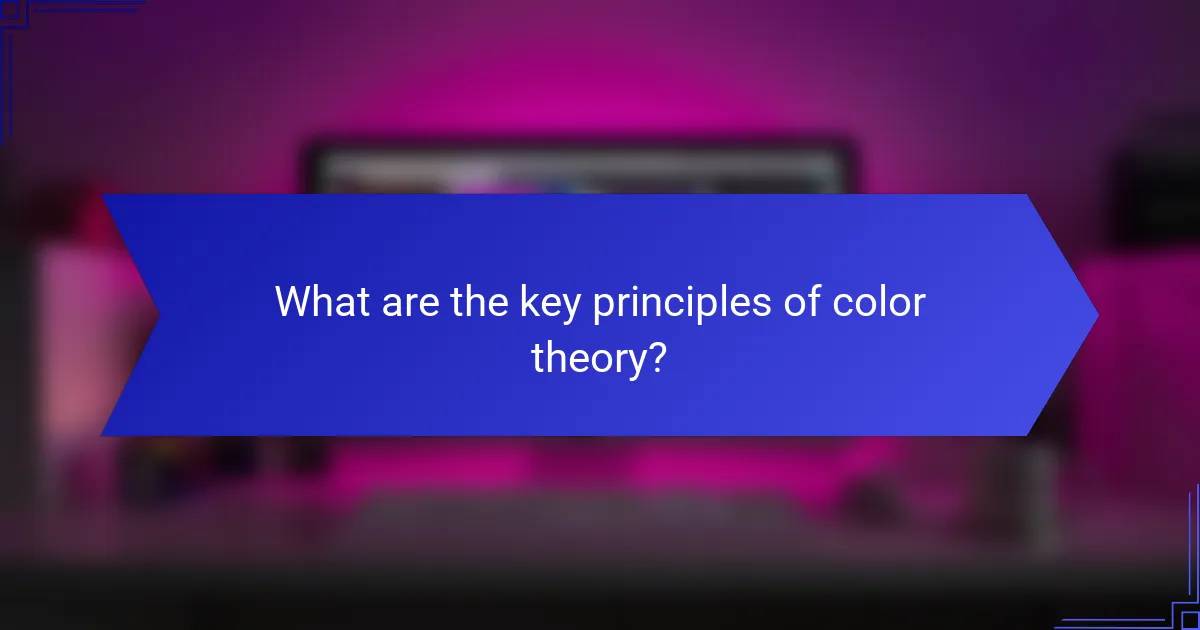Color theory techniques play a crucial role in enhancing design projects by improving visual appeal and communication. By understanding the relationships and interactions between colors, designers can create engaging and effective visuals that evoke specific emotions and responses. These principles are applied across various fields, including graphic design, interior design, and marketing, to achieve targeted objectives and enhance overall visual communication.

How can color theory techniques enhance design projects?
Color theory techniques significantly enhance design projects by improving visual appeal and communication. By understanding how colors interact and influence perception, designers can create more effective and engaging designs.
Improved visual communication
Color theory aids in visual communication by establishing clear associations and hierarchies within design. For instance, using contrasting colors can highlight important information, while harmonious color schemes can create a cohesive look. Designers should consider color combinations that enhance readability and guide the viewer’s eye effectively.
Utilizing tools like color wheels and contrast checkers can help ensure that color choices are not only aesthetically pleasing but also functional in conveying messages.
Increased emotional impact
Colors evoke emotions and can significantly influence how a design is perceived. For example, warm colors like red and orange can create feelings of excitement or urgency, while cool colors like blue and green often evoke calmness and trust. Understanding these emotional responses allows designers to select colors that align with the intended message or brand identity.
When designing for specific audiences, consider cultural differences in color perception to ensure the emotional impact is appropriate and effective.
Enhanced brand recognition
Consistent use of color in branding can enhance recognition and recall. Brands like Coca-Cola and Tiffany & Co. have effectively used specific colors to create a strong identity. By establishing a unique color palette, businesses can differentiate themselves in a crowded market.
To build brand recognition, ensure that color choices are consistently applied across all marketing materials, from logos to packaging, to reinforce the brand’s visual identity.
Better user experience
Color theory can improve user experience by guiding users through a design intuitively. Effective use of color can indicate actions, such as using green for “go” and red for “stop.” This helps users navigate interfaces more easily and reduces cognitive load.
Testing color choices with real users can provide insights into how well the design communicates its purpose and whether it meets user expectations.
Effective marketing strategies
In marketing, color choices can influence consumer behavior and decision-making. Research suggests that up to 90% of snap judgments about products are based on color alone. Marketers should leverage color psychology to craft campaigns that resonate with target audiences.
For instance, using vibrant colors in promotional materials can attract attention, while softer hues may be more suitable for luxury products. Tailoring color strategies to align with brand values and target demographics can enhance marketing effectiveness.

What are the key principles of color theory?
The key principles of color theory involve understanding how colors interact, their relationships, and how they can be combined to create visually appealing designs. These principles guide artists and designers in making informed choices about color usage to evoke specific emotions and achieve desired effects.
Color wheel fundamentals
The color wheel is a circular diagram that illustrates the relationships between colors. It typically includes primary colors (red, blue, yellow), secondary colors (green, orange, purple), and tertiary colors, which are created by mixing primary and secondary colors. Understanding the color wheel helps in identifying complementary and harmonious color combinations.
When using the color wheel, consider the placement of colors to create balance in your designs. For example, colors that are opposite each other on the wheel, known as complementary colors, can create high contrast and visual interest.
Complementary colors
Complementary colors are pairs of colors that are located directly opposite each other on the color wheel. For instance, red and green or blue and orange are classic examples. Using complementary colors together can create vibrant contrasts that draw attention and enhance visual impact.
When applying complementary colors, be mindful of the balance between them. Too much of one color can overwhelm the other, so consider using one as a dominant color and the other as an accent to maintain harmony.
Analogous colors
Analogous colors are groups of three colors that are next to each other on the color wheel, such as blue, blue-green, and green. These colors share similar hues, which creates a serene and cohesive look when used together. They are often found in nature and can evoke a sense of harmony and unity.
To effectively use analogous colors, select one color as the dominant hue and the others as supporting colors. This approach can help create depth while maintaining a visually pleasing palette.
Triadic color schemes
Triadic color schemes consist of three colors that are evenly spaced around the color wheel, such as red, yellow, and blue. This scheme provides a vibrant and balanced look, making it suitable for dynamic designs. Triadic combinations can be particularly effective in graphic design and art.
When implementing a triadic color scheme, choose one color to dominate while using the other two as accents. This method helps maintain visual interest without overwhelming the viewer.
Color harmony concepts
Color harmony refers to the aesthetically pleasing arrangement of colors in a design. Achieving color harmony involves using color theory principles to create a balanced and cohesive look. Techniques such as complementary, analogous, and triadic color schemes are essential for establishing harmony.
To ensure color harmony, consider the emotional response you want to evoke and the context of your design. Experiment with different combinations and pay attention to how colors interact to create a unified visual experience.

What applications utilize color theory techniques?
Color theory techniques are widely used across various fields to enhance visual communication and evoke emotional responses. These applications include graphic design, interior design, fashion, web design, and marketing, each leveraging color principles to achieve specific goals.
Graphic design projects
In graphic design, color theory is essential for creating visually appealing layouts that convey messages effectively. Designers often use color harmonies, such as complementary and analogous schemes, to create balance and focus. For instance, a vibrant color palette can attract attention, while muted tones may evoke calmness.
When selecting colors, consider the target audience and the emotions you wish to evoke. A good practice is to limit the palette to three to five main colors to maintain cohesion and clarity in the design.
Interior design choices
Interior design heavily relies on color theory to create spaces that feel inviting and functional. Designers often choose colors based on the mood they want to establish; for example, warm colors like reds and oranges can energize a room, while cool colors like blues and greens promote relaxation.
When planning a color scheme, consider the size and lighting of the space. Lighter colors can make small rooms feel larger, while darker shades can add warmth and intimacy. A common approach is to use a neutral base and add pops of color through accessories.
Fashion industry trends
In fashion, color theory influences trends and seasonal collections, helping designers create garments that resonate with consumers. Color forecasting plays a crucial role, as designers look to predict which hues will be popular in upcoming seasons.
Understanding color psychology is vital; for instance, black is often associated with elegance, while bright colors can signify playfulness. Designers frequently use color blocking—pairing contrasting colors—to create bold statements in their collections.
Web design best practices
Web design utilizes color theory to enhance user experience and guide navigation. Effective color choices can improve readability and accessibility, ensuring that content is easily digestible. For example, high-contrast text and background combinations are essential for legibility.
When designing a website, stick to a consistent color palette that aligns with your brand identity. A common guideline is to use one primary color, one secondary color, and a few accent colors to create visual interest without overwhelming the user.
Marketing materials
Color theory is crucial in marketing materials, as colors can significantly influence consumer behavior. Brands often select colors that align with their values; for instance, green is frequently associated with sustainability, while blue conveys trust and reliability.
When creating marketing materials, consider the emotional impact of colors on your target audience. A/B testing different color schemes can provide insights into which combinations yield the best engagement and conversion rates. Aim for a cohesive look across all materials to strengthen brand recognition.

How do color theory techniques benefit e-commerce?
Color theory techniques enhance e-commerce by influencing customer emotions and behaviors, leading to improved engagement and sales. By strategically applying color principles, online retailers can create visually appealing websites that resonate with their target audience.
Increased conversion rates
Utilizing effective color combinations can significantly boost conversion rates on e-commerce sites. For instance, using contrasting colors for call-to-action buttons can draw attention and encourage clicks, potentially increasing sales by a notable margin. A/B testing different color schemes can help identify which combinations yield the highest conversion rates.
Consider using warm colors like red or orange for urgency and excitement, while cooler tones like blue can evoke trust and calmness. Tailoring color choices to align with your brand identity and customer preferences is crucial for maximizing impact.
Enhanced product visibility
Color theory techniques can improve product visibility by making items stand out against the background and other elements on a webpage. High-contrast colors can help highlight key features and details, ensuring that customers notice and engage with products more effectively.
For example, using a bright color for a sale banner against a neutral background can attract attention quickly. Additionally, employing color coding for categories or promotions can streamline navigation and enhance the overall shopping experience, making it easier for customers to find what they need.
